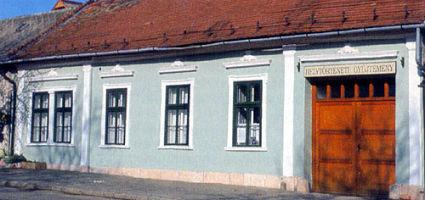2024. May 4. Saturday
Dr. István Jablonkay Region Historical Museum - Solymár
 |
Address: 2083, Solymár Templom tér 2.
Phone number: (70) 637-7499
E-mail: muzeum@apaczai.com
Opening hours: Wed 14-18, Thu12-16, Sat 9-14
|
The exhibition has closed for visitors.
2015.09.05. - 2015.10.04.
Museum tickets, service costs:
|
Ticket for adults
|
400 HUF
|
|
|
Ticket for students
|
200 HUF
|
The boy was raised in a family of eight children inherited dexterity from his father. After leaving grammar school, he began working at the furniture factory of Székely and Réti in Marosvásárhely, where he learned wood carving. He began studying Fine Arts with Antal Orbán, where he was a private student. He moved to Budapest in 1929, in 1930 he was admitted in the Academy of Fine Arts, where his tutor was Zsigmond Kisfaludi Strobl, then, after graduating from college he was Kisfaludi's teaching assistance for five years (1935-1938). His first exhibition was in 1932 when he was still at collage. In 1938 he moved to Rome where he spent the next two years on, state scholarship. This period had a great impact on his art. He replaced academic naturalism by the Roman School style.

His nudes, portraits, animal figures could be characterised by schematism in the 1950 and abstraction, even surrealism in the 1960s. His art was more like that of Ferenc Medgyessy, mainly with his statuettes with themes of peasant life. During the last decade of his creative period he did cubist-constructivist-figurative statuettes, and also sculptures made of wood. After 1966 he worked for several years with his sister's son, the sculptor László Péterfy in the studio in the Várkert Bazaar.
In addition to the nearly 50 statues located in public places, his statuettes and medals are also significant. Counting all his works, he did around five-hundred works, among them one-hundred medals and plaques. His works are found in public places, buildings, museums and private collections. More than thirty of his statues are held by the Hungarian National Gallery, many of them are in the Physical Education and -Sports Museum. In 1952 he joined the Spiritual Artists Association.<br /><br />One of his most significant work is from 1935, the 'Onlooker Boy'. The one and a half meter high nude statue depicts a teenage boy in a somewhat sloppy posture and mild bestride. The young artist, breaking from the usual Greek beauty ideal and harmony of motion, sought to depict actual people. The suggestive and powerful work was awarded by the Káldy Prize. The composition was cast in bronze in 1978 and was set up in a park at the József Attila housing estate in the IX. district, at the corner of Toronyház Street and Lobogó Street.

His nudes, portraits, animal figures could be characterised by schematism in the 1950 and abstraction, even surrealism in the 1960s. His art was more like that of Ferenc Medgyessy, mainly with his statuettes with themes of peasant life. During the last decade of his creative period he did cubist-constructivist-figurative statuettes, and also sculptures made of wood. After 1966 he worked for several years with his sister's son, the sculptor László Péterfy in the studio in the Várkert Bazaar.
In addition to the nearly 50 statues located in public places, his statuettes and medals are also significant. Counting all his works, he did around five-hundred works, among them one-hundred medals and plaques. His works are found in public places, buildings, museums and private collections. More than thirty of his statues are held by the Hungarian National Gallery, many of them are in the Physical Education and -Sports Museum. In 1952 he joined the Spiritual Artists Association.<br /><br />One of his most significant work is from 1935, the 'Onlooker Boy'. The one and a half meter high nude statue depicts a teenage boy in a somewhat sloppy posture and mild bestride. The young artist, breaking from the usual Greek beauty ideal and harmony of motion, sought to depict actual people. The suggestive and powerful work was awarded by the Káldy Prize. The composition was cast in bronze in 1978 and was set up in a park at the József Attila housing estate in the IX. district, at the corner of Toronyház Street and Lobogó Street.
